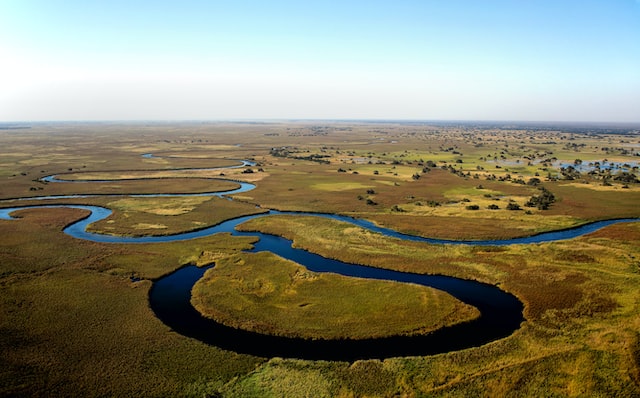Okavango Delta in Botswana’ The 7th Wonder of Africa

- About the Okavango Delta in Botswana
- Formation of Okavango Delta in Botswana
- Wild Life of Okavango Delta in Botswana
Africa facts zone presents one of the Seven Wonders of Africa, The Okavango Delta in Botswana. Okavango Delta is a one-of-a-kind beating wetland.
The delta covers somewhere in the range of 6 and 15 000 square kilometers of the Kalahari Desert in northern Botswana.
Its presence in the Okavango (Kavango) Waterway streams from the Angolan high countries, across Namibia’s Caprivi Strip, and into the brutal Kalahari Desert.
A desert garden inside the Kalahari Desert, the Okavango Delta is one of the incredible natural life asylums of Africa.
The pulsing nature of the wetland prompts strikingly various scenes with both long-lasting and occasional delta conditions.
The Okavango Delta in Botswana is a tremendous and different biological system made as the Okavango Waterway streams into the Kalahari desert in Botswana.
Wealthy in natural life, this World Heritage Site is a safe haven for a portion of the world’s most jeopardized creatures and birds.
Also Read: Botswana Facts, History, Culture & Travel
About the Okavango Delta in Botswana

The Okavango Delta in Botswana lies in the northwest of Botswana. Part of the Incomparable East African Rift Valley system.
The Okavango Delta is formed as the Okavango river streams into the Kalahari Desert from the Angolan high countries.
This makes a special wetland, an immense desert garden that sets the district’s beat with its yearly heartbeats.
There is under 2 meters variety in level across the whole 250-kilometer length of the Delta.
It is this practically complete shortfall of geological help that prompts the development of the myriad waterways that make up the Delta.
The immense amounts of water streaming into the practically level desert bring about a labyrinth of winding channels, oxbow lakes, islands, and floodplains.
The water is at last halted in its frightful advancement by a separation point. It truly is a scene like no other.
Around 11 cubic kilometers stream into the Delta every year.
The water streams persistently into the Delta and channels the late spring (January to February) precipitation from the Angolan good countries.
A flood, that streams a stunning 1200 kilometers in a month, happens in Botswana between Spring and June. It is during this time that the Okavango Delta is at its biggest.
Also Read: What is the 7 Wonders of the World
The high temperatures in the district cause rapid transpiration and evaporation which brings about a pattern of rising and falling water levels.
As one of the main wellsprings of water during the dry time frame, the Okavango Delta in Botswana draws in a large number of creatures and is one of Africa’s most noteworthy centralizations of wildlife.
The genuine wonder of this desert garden in the desert is that the rising waters show up right when the rainy season has finished and water and food are turning out to be scant in the locale.
The waters of the yearly flood genuinely are waters of life.
Once in the Delta, water is lost to happening by plants (60%), dissipation (36%), permeation into the spring framework (2%) lastly, 2% streams out into Lake Ngami.
The islands of the Delta generally start as termite hills (70%) and frequently have white patches in their middle where the high salt substance of the islands gathers.
This cycle makes the islands become harmful and trees vanish in the middle.
At the focal point of the Delta is Chief’s Island, the biggest island in the Delta. Chief’s Island was formed by a separation point that inspired a 70 x 15 km wide region.
Plentiful in animal life, it was once saved as a hunting region for the chief and presently formed a protected relief for the occupant’s wildlife when the waters rise.
Formation
The Okavango Delta in Botswana is formed when a great river streams not into the ocean but rather into the center of the southern African mainland expanse of land.
It is all the more accurately named an alluvial fan involving regions that are forever, occasionally and at times overflowed.
The Delta is the perfection of a waterway framework that has its catchment regions in Angola.
It flows through Namibia and afterward into Botswana where different cycles oversee the conveyance across the alluvial fan.
These cycles are both physical and subject to a slant, sedimentation blames and diverts cut quite a while in the past in the Kalahari sands.
It is likewise organic, molded by hippopotami moving their direction along the streams, termites building their many-sided hills and the normal development of papyrus.
With such countless elements molding the Okavango, it isn’t business as usual that the progression of water is variable and capricious.
The Delta comprises of a large number of primary channels, more modest feeders and tidal ponds as well as floodplains, islands, and central area regions.
The conduits are continuously changing because of yearly flooding as well as a mix of residue transport, and seismic movement.
The development of termite hills, the persistent opening up of new channels by taking care of hippopotami, and the end of others by new vegetation development.
Likewise Read: The Khoemacau Copper Mine Botswana, Africa’s Biggest Copper Mine
Untamed life
The wildlife of the Okavango Delta in Botswana is different and copious thanks to the rich environments and assurance.
The Okavango Delta upholds enormous convergences of creatures on both an extremely durable and occasional premise.
Through cautious wildlife management, it has become maybe one of the most amazing spots to see wild life in Africa.
There is a powerful occasional shift of creatures between the bone-dry district that encompasses the delta and the Okavango Delta itself.
During the wet season, most huge creatures get away from the delta to exploit the rich grazing that encompasses it.
Also Read: The Khoemacau Copper Mine Botswana, Africa’s Largest Copper Mine
Wild Life
The wildlife of the Okavango Delta in Botswana is different and copious thanks to the rich environments and assurance.
The Okavango Delta upholds enormous convergences of creatures on both an extremely durable and occasional premise.
Through cautious wildlife management, it has become maybe one of the most amazing spots to see wild life in Africa.
There is a powerful occasional shift of creatures between the bone-dry district that encompasses the delta and the Okavango Delta itself.
During the wet season, most huge creatures get away from the delta to exploit the rich grazing that encompasses it.
Also Read: Botswana Facts, History, Culture & Travel
As this grazing begins to die in the colder time of year creatures move back to the delta.
Wildlife of the Okavango Delta incorporates a bunch of animal categories including African Bramble elephants, African Buffalo, Hippopotamus, and Lechwe.
Topi, Blue Wildebeest, Giraffe, Nile crocodile, Lion, Cheetah, Panther, Earthy colored Hyena, Spotted Hyena, and More noteworthy Kudu, Sable Gazelle.
Dark Rhinoceros, White Rhinoceros, Fields Zebra, Warthog, and Chacma Mandrill.
Prominently, the imperiled African Wild Dog still survives inside the Okavango Delta and displays one of the most extravagant pack densities in Africa.
Notwithstanding the enormous creatures, the wildlife of the Okavango Delta in Botswana incorporates more than 500 types of birds.
It additionally has 85 recorded types of fish including Tigerfish, Tilapia, and Catfish.
Okavango delta lions’ The Biggest Lions Ever
Male lions in the Okavango Delta in Botswana, are the biggest lions on earth.
This was said by producer Dereck Joubert. Dereck and his wife, Beverly, are both National Geographic explorers. They made a film about how these male lions survive.
Lions in Botswana’s Okavango Delta are the biggest lions ever on the planet.
This is on the grounds that there is an overflow of buffalo and various animals to chase in the district.
Furthermore, the manner in which the lions regularly walk around water in the delta’s many streams, fosters/develops their muscles, Dereck said.
Also Read: African Lions Plus Facts About African Lions
KEYSTONE SPECIES
The Okavango Delta in Botswana wouldn’t exist as far as we might be concerned without the assistance of various cornerstone species.
They help to shape the climate and living spaces in and around the Delta. These eco-framework engineers incorporate the elephant, hippo, and termites.
When to Visit

The Okavango Delta in Botswana is one of the most unique safari destinations in Africa.
Making it all the seriously charming. Each season is unique and for sure every year can be different as well.
The Okavango is an all-year destination.
With cautious planning in light of profound comprehension of this mind-boggling climate, you can partake in a brilliant safari whenever of year.
The best chance to visit will rely upon your specific interests.
Customarily the dry season, when amazingly the Okavango waters are most noteworthy.
This offers the best game survey as the creatures rush to the waters from the dry hinterland.
This is additionally when many camps can offer water exercises.
Notwithstanding, there are exemptions, October for instance is the driest and most blazing month and conveys great game reviews however ordinarily has low water levels.
Also Read: The Mystery of the Pink Lake in Senegal Lac Rose also known as Lake Retba
The shoulder months (mid-season) have a lot to suggest as well.
November brings the principal nurturing downpours and the land springs to life.
A dazzling green rug over the fields shows up and the calving season for some antelope, like impala, starts.
In the event that you are a birder the best time to visit is for the most part throughout the mid year months.
This is the point at which the Okavango Delta in Botswana is overflowing with the occupant and transitory birds.
The air is loaded with melody and glimmers of variety.
All things considered, a portion of the heronries are best visited later in the year, so this also will rely upon your own inclination.
The phenomenal game survey can be appreciated in the late spring months as well, in the right regions with great occupant games and long-lasting water channels.
These months additionally see the longest movement in Africa.
A huge number of zebra move to the salt pans, a shocking sight.
Consistently conveys an alternate encounter and with cautious preparation, you can have a heavenly safari in the Okavango whenever of year.
Also Read: Zebra Fun Facts Plus What sound does a zebra make?
INTERNATIONAL RECOGNITION
Worldwide Acknowledgment
The natural significance and ‘Remarkable General Worth of the Okavango Delta have been perceived by UNESCO and the RAMSAR Convention.
The Okavango Delta was assigned a Wetland of Global Significance in 1996 and a World Heritage Site in 2016.
Together these worldwide bodies mean to safeguard the fate of this special and delicate ecosystem.




